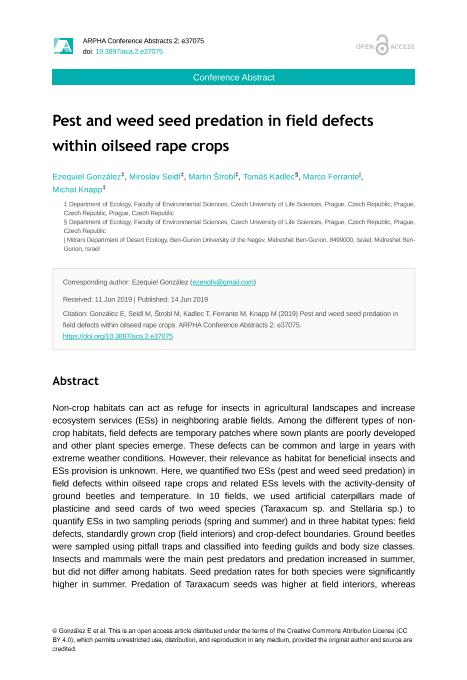Mostrar el registro sencillo del ítem
dc.contributor.author
González, Ezequiel

dc.contributor.author
Seidl, Miroslav
dc.contributor.author
Strobl, Martin
dc.contributor.author
Kadlec, Tomás
dc.contributor.author
Ferrante, Marco
dc.contributor.author
Knapp, Michal
dc.date.available
2022-06-21T10:23:13Z
dc.date.issued
2021
dc.identifier.citation
Pest and weed seed predation in field defects within oilseed rape crops; 19th European Carabidologists Meeting; San Martino di Castrozza; Italia; 2019; 1-1
dc.identifier.uri
http://hdl.handle.net/11336/160041
dc.description.abstract
Non-crop habitats can act as refuge for insects in agricultural landscapes and increase ecosystem services (ESs) in neighboring arable fields. Among the different types of non-crop habitats, field defects are temporary patches where sown plants are poorly developed and other plant species emerge. These defects can be common and large in years with extreme weather conditions. However, their relevance as habitat for beneficial insects and ESs provision is unknown. Here, we quantified two ESs (pest and weed seed predation) in field defects within oilseed rape crops and related ESs levels with the activity-density of ground beetles and temperature. In 10 fields, we used artificial caterpillars made of plasticine and seed cards of two weed species (Taraxacum sp. and Stellaria sp.) to quantify ESs in two sampling periods (spring and summer) and in three habitat types: field defects, standardly grown crop (field interiors) and crop-defect boundaries. Ground beetles were sampled using pitfall traps and classified into feeding guilds and body size classes. Insects and mammals were the main pest predators and predation increased in summer, but did not differ among habitats. Seed predation rates for both species were significantly higher in summer. Predation of Taraxacum seeds was higher at field interiors, whereas predation of Stellaria was significantly higher at field interiors and defects, compared to crop-defect boundaries. Insect predation increased with the activity-density of medium and large carnivorous carabids, whereas seed predation for both weed species was positively related to the activity-density of medium-sized herbivorous carabids. Finally, temperature was negatively linked to predation of artificial caterpillars and seeds of Taraxacum.
dc.format
application/pdf
dc.language.iso
eng
dc.publisher
Pensoft Publishers

dc.rights
info:eu-repo/semantics/openAccess
dc.rights.uri
https://creativecommons.org/licenses/by-nc-sa/2.5/ar/
dc.subject
BIOLOGICAL CONTROL
dc.subject
EPHEMERAL HABITATS
dc.subject
GROUND BEETLES
dc.subject
NON-CROP HABITATS
dc.subject.classification
Agricultura

dc.subject.classification
Agricultura, Silvicultura y Pesca

dc.subject.classification
CIENCIAS AGRÍCOLAS

dc.title
Pest and weed seed predation in field defects within oilseed rape crops
dc.type
info:eu-repo/semantics/publishedVersion
dc.type
info:eu-repo/semantics/conferenceObject
dc.type
info:ar-repo/semantics/documento de conferencia
dc.date.updated
2022-06-03T18:34:46Z
dc.journal.volume
2
dc.journal.number
e37075
dc.journal.pagination
1-1
dc.journal.pais
Italia

dc.journal.ciudad
Fiera di Primiero
dc.description.fil
Fil: González, Ezequiel. Czech University Of Life Sciences; República Checa. Consejo Nacional de Investigaciones Científicas y Técnicas. Centro Científico Tecnológico Conicet - Córdoba. Instituto Multidisciplinario de Biología Vegetal. Universidad Nacional de Córdoba. Facultad de Ciencias Exactas Físicas y Naturales. Instituto Multidisciplinario de Biología Vegetal; Argentina
dc.description.fil
Fil: Seidl, Miroslav. Czech University Of Life Sciences; República Checa
dc.description.fil
Fil: Strobl, Martin. Czech University Of Life Sciences; República Checa
dc.description.fil
Fil: Kadlec, Tomás. Czech University Of Life Sciences; República Checa
dc.description.fil
Fil: Ferrante, Marco. Ben Gurion University of the Negev; Israel
dc.description.fil
Fil: Knapp, Michal. Czech University Of Life Sciences; República Checa
dc.relation.alternativeid
info:eu-repo/semantics/altIdentifier/url/https://aca.pensoft.net/article/37075/
dc.relation.alternativeid
info:eu-repo/semantics/altIdentifier/doi/http://dx.doi.org/10.3897/aca.2.e37075
dc.conicet.rol
Autor

dc.conicet.rol
Autor

dc.conicet.rol
Autor

dc.conicet.rol
Autor

dc.conicet.rol
Autor

dc.conicet.rol
Autor

dc.coverage
Internacional
dc.type.subtype
Reunión
dc.description.nombreEvento
19th European Carabidologists Meeting
dc.date.evento
2019-09-16
dc.description.ciudadEvento
San Martino di Castrozza
dc.description.paisEvento
Italia

dc.type.publicacion
Journal
dc.description.institucionOrganizadora
Czech University of Life Sciences. Faculty of Environmental Sciences
dc.source.revista
Arpha Conference Abstracts
dc.date.eventoHasta
2019-09-19
dc.type
Reunión
Archivos asociados
